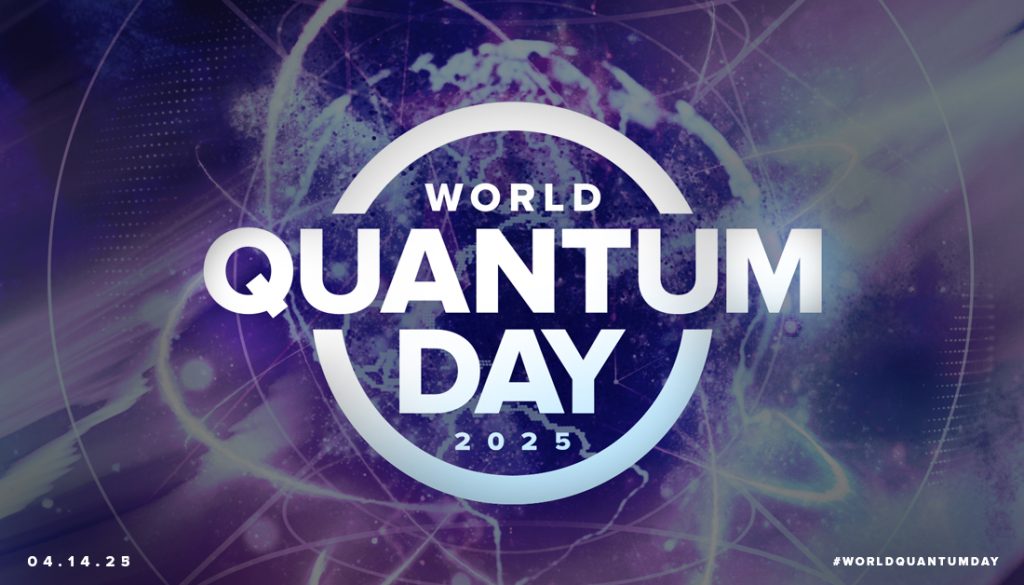
Happy World Quantum Day!
April 14th — or “4.14” — celebrates Planck’s constant (rounded to 3 digits), which is the fundamental constant that sets the tiny size-scale of quantum phenomena. This celebration is a result of an initiative driven by quantum scientists worldwide intended to promote public understanding of quantum science and technology. Read on to see some of the ways that Federal agencies are marking World Quantum Day in 2025. Find even more quantum resources for World Quantum Day and beyond at https://www.quantum.gov/iyq-2025/. Share how you’re celebrating with #WorldQuantumDay or use the 2025 World Quantum Day public domain graphics.
The Air Force Office of Scientific Research (AFOSR) has funded research to boost communications rates for quantum networks. An AFOSR-funded university researcher developed a scalable solid-state quantum network with the first demonstration of multiplexed quantum bits to significantly boost communication rates between quantum nodes, tackling a major quantum networking bottleneck. The networked quantum devices could be a game changer for the Air Force, boosting operational decision-making coupled with secure communications and computations directly affecting ground, air, and space assets. This research was published in Nature (2025).
The U.S. Department of Energy (DOE) funds five National Quantum Information Science Research Centers. These centers are focused on complementary, interconnected areas including building the quantum workforce. They are accelerating breakthroughs in quantum computing, communication, materials, and sensing through collaborative, multi-institutional research. Each center incorporates a collaborative team of labs, universities, and companies spanning a broad range of scientific and engineering disciplines, including over 1,500 experts across 115 academic, industry, and national science institutions. DOE also funds quantum computing testbeds that provide research access to cutting-edge quantum hardware. Cloud access to state-of-the-art commercial quantum computing platforms is available through the Oak Ridge Leadership Computing Facility and Quantum @ NERSC. Learn more at the DOE Office of Science QIS website.
The National Institute of Standards and Technology (NIST) develops measurement science techniques, tools, and related standards to enhance the competitiveness of the U.S. quantum industry and the economic well-being and national security of the United States. NIST has become a world leader in quantum science and technology based on decades of fundamental research. Quantum technologies developed by NIST — from new encryption algorithms to world-leading sensors and deployable standards — provide transformative solutions for national challenges and have resulted in the creation of multiple spin-out companies. NIST activities include research coming out of three joint institutes focused on different aspects of quantum information science: JILA, the Joint Quantum Institute and the Joint Center for Quantum Information and Computer Science. Check out the NIST International Year of Quantum website where you will find NIST’s most influential and important quantum papers, quantum explainers, and so much more: https://www.nist.gov/physics/international-year-quantum
For decades, the U.S. National Science Foundation (NSF) has invested in the foundational research and development driving the quantum revolution. The NSF funds Quantum Leap Challenge Institutes around the country and recently announced the final six pilot projects selected for the NSF National Quantum Virtual Laboratory initiative, an ambitious effort to accelerate the development of quantum technologies by providing researchers anywhere in the U.S. with access to specialized resources. Learn more at: https://www.nsf.gov/focus-areas/quantum.
Nanotechnology plays a major role in the development of quantum information technologies. The National Nanotechnology Initiative community has enabled and accelerated advancements in building better qubits, improving quantum sensing, developing ways to run a quantum computer at higher temperatures, and making quantum computing more accurate and reliable with superconducting nanowire single-photon detectors. Learn more at https://www.nano.gov.

